EARTHQUAKES HAVE ASTRONOMIC ORIGIN. THE 4 UNIFYING THEORETICAL BASES.
Il 22.09.2022 sono accaduti molti terremoti in una sola giornata in Italia, di cui 4 ≥M3.6, in diverse parti d’Italia, dopo mesi di “silenzio sismico”: perché? I geologi negano che possa esserci un qualunque collegamento tra tutti i terremoti di quel giorno. Eppure, una spiegazione di collegamento c’è, ricavata dalla stessa Letteratura pubblicata dalla medesima categoria di Ricercatori che la negano.
On 22.09.2022 many earthquakes occurred in a single day in Italy, of which 4 ≥M3.6, in different parts of Italy, after months of “seismic silence”: why? Geologists deny that there could be any connection between all the earthquakes that day. Yet, there is a connection explanation, drawn from the same literature published by the same category of researchers who deny it.
LA SEQUENZA SISMICA DEL 22.09.2022 [CREDITS: GEOPOP]
Non so spiegare la natura geologica della sismicità così spiccata dello scorso 22.09.2022 in Italia, ma posso certamente dare delle spiegazioni esaustive dal punto di vista astronomico.
I do not know how to explain the geological nature of the seismicity so marked last 22.09.2022 in Italy, but I can certainly give exhaustive explanations from the astronomical point of view.

Ne avevo parlato tempo fa, in questo post:
I talked about it some time ago, in this post:
https://www.facebook.com/…/permalink/787546804736115/.
LA CICLICITÀ DEI TERREMOTI.
I Terremoti sono caratterizzati nel loro accadere dallo scadenzarsi di un tempo ciclico, un tempo cioè che non è il tempo solare a noi noto (del nostro orologio, basato su minuti da 60 secondi e ore da 60 minuti), ma un tempo che possiamo chiamare “TEMPO GRAVITAZIONALE”.
I SISMI RISULTEREBBERO QUINDI COME EVENTI CICLICI E REGOLARI, ma non scanditi dal tempo solare (il tempo che è nell’orologio che hai al polso, per intendersi). Nemmeno intendo il ciclo undecennale delle macchie solari di Bendandi (V. http://www.aibba.it/EAR…/UnprincipioUniversaleBendandi.pdf). Intendo invece un “TEMPO GRAVITAZIONALE”, un tempo cioè scandito dagli allineamenti dei pianeti del sistema solare con la Terra (ESCLUDENDO il sistema Sole/Luna/Terra), un tempo che “cadenza” i picchi sismici con sorprendente regolarità!
Un orologio scadenzato da un tempo che NON risulta però regolare e costante, come se lo calcolassimo con il tempo tradizionale SOLARE, cioè come è calcolato dal nostro orologio che teniamo al polso tutti quanti.
È un tempo dettato dal susseguirsi regolare di effetti gravitazionali, causati dalla specifica rivoluzione dei pianeti lungo le loro orbite e dalla conseguente posizione in linea che assumono nei confronti della Terra, come già molte volte spiegato.
È UN TEMPO DEL “SISTEMA SOLARE” CON LA TERRA: UN NUOVO ORDINE CRONOLOGICO!
THE CYCLING OF EARTHQUAKES.
Earthquakes are characterized in their occurrence by the expiration of a cyclic time, a time that is not the solar time known to us (of our clock, based on 60-second minutes and 60-minute hours), but a time that we can call “GRAVITATIONAL TIME”.
THE EARTHQUAKES WOULD RESULT AS CYCLIC AND REGULAR EVENTS, but not marked by solar time (the time that is in the watch on your wrist, so to speak). Nor do I mean the eleven-year cycle of Bendandi’s sunspots (See http://www.aibba.it/EAR…/UnprincipioUniversaleBendandi.pdf). Instead I mean a “GRAVITATIONAL TIME”, a time marked by the alignments of the planets of the solar system with the Earth (EXCLUDING the Sun / Moon / Earth system), a time that “cadence” seismic peaks with surprising regularity!
A watch with a deadline that is NOT regular and constant, as if we calculated it with the traditional SOLAR time, that is, as it is calculated by our watch that we all keep on our wrists.
It is a time dictated by the regular succession of gravitational effects, caused by the specific revolution of the planets along their orbits and by the consequent position in line they assume towards the Earth, as already explained many times.
IT IS A TIME OF THE “SOLAR SYSTEM” WITH EARTH: A NEW CHRONOLOGICAL ORDER!
I terremoti hanno un andamento ciclico, dettato dalla posizione degli astri che, grazie alla rotazione della Terra ripresentano le stesse condizioni gravitazionali col passare delle ore, causando l’innesco di nuovi terremoti con regolarità ciclica.
INGV, come si evince dall’articolo di Repubblica allegato, invece smentisce ogni possibile legame tra i diversi terremoti: credo che manchi loro qualche informazione! ![]()
Earthquakes have a cyclical pattern, dictated by the position of the stars which, thanks to the rotation of the Earth, present the same gravitational conditions over the hours, causing the triggering of new earthquakes with cyclical regularity.
INGV, as can be seen from the attached Repubblica article, instead denies any possible link between the different earthquakes: I think they lack some information! ☺️

Infatti, ecco le 4 più forti tra le 5 scosse accadute il 22.09.2022 in Italia:
In fact, here are the 4 strongest among the 5 tremors that occurred on 09.22.2022 in Italy:
1)
Tutto è cominciato con il Terremoto di magnitudo ML 3.6 del 22-09-2022 ore 02:21:27 (UTC) in zona: 4 km S Paternò (CT)
2)
Poi, è seguito il terremoto di magnitudo Mw 3.9 del 22-09-2022 ore 10:24:48 (UTC) in zona: 4 km SW Folignano (AP).
3)
Poi, un’altro sciame ed il Terremoto di magnitudo ML 4.1 del 22-09-2022 ore 13:39:59 (UTC) in zona: 2 km W Bargagli (GE).
4)
Ancora, il Terremoto di magnitudo ML 3.8 del 22-09-2022 ore 15:47:57 (UTC) in zona: 8 km W Pievepelago (MO).
La condizione astronomica di oggi e la magnitudo attesa erano ben previste dalla Timeline (v. allegato), che indicava per oggi una certa stabilità delle forze Newton provenienti dallo spazio.
The astronomical condition of today and the expected magnitude were well foreseen by the Timeline (see attachment), which indicated for today a certain stability of the Newton forces coming from space.
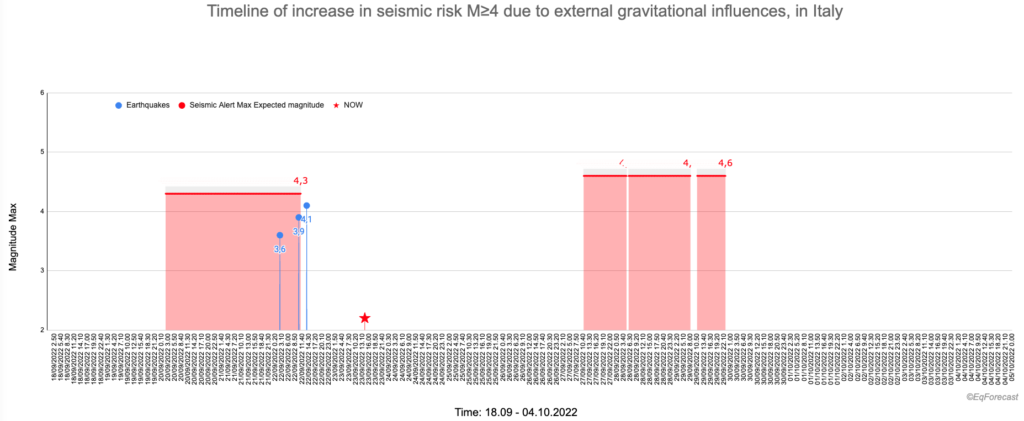
L’innesco sismico. The seismic trigger.
L’innesco sismico, ci dicono i geofisici, deriva dalla componente verticale delle maree di origine luni-solare (sia solida che liquida), che può innescare sismicità solo al raggiungimento della soglia di energia orizzontale accumulata nel corso di decine (o centinaia) di anni dalla faglia [Davide Zaccagnino, Francesco Vespe, Carlo Doglioni, Tidal modulation of plate motions, Earth-Science Reviews, Volume 205, 2020, 103179, ISSN 0012-8252, https://doi.org/10.1016/j.earscirev.2020.103179 (2020)]: quindi è un condizione astronomica esterna quella necessaria all’innesco dei terremoti, come riconoscono gli stessi ricercatori, non dipende esclusivamente da forze endogene al terreno!
The seismic trigger, the geophysicists tell us, derives from the vertical component of the tides of lunar-solar origin (both solid and liquid), which can trigger seismicity only when the horizontal energy threshold accumulated over tens (or hundreds) of years from the fault [Davide Zaccagnino, Francesco Vespe, Carlo Doglioni, Tidal modulation of plate motions, Earth-Science Reviews, Volume 205, 2020, 103179, ISSN 0012-8252, https://doi.org/10.1016/j.earscirev. 2020.103179 (2020)]: therefore it is an external astronomical condition that is necessary for the triggering of earthquakes, as the researchers themselves recognize, it does not depend exclusively on forces endogenous to the ground!
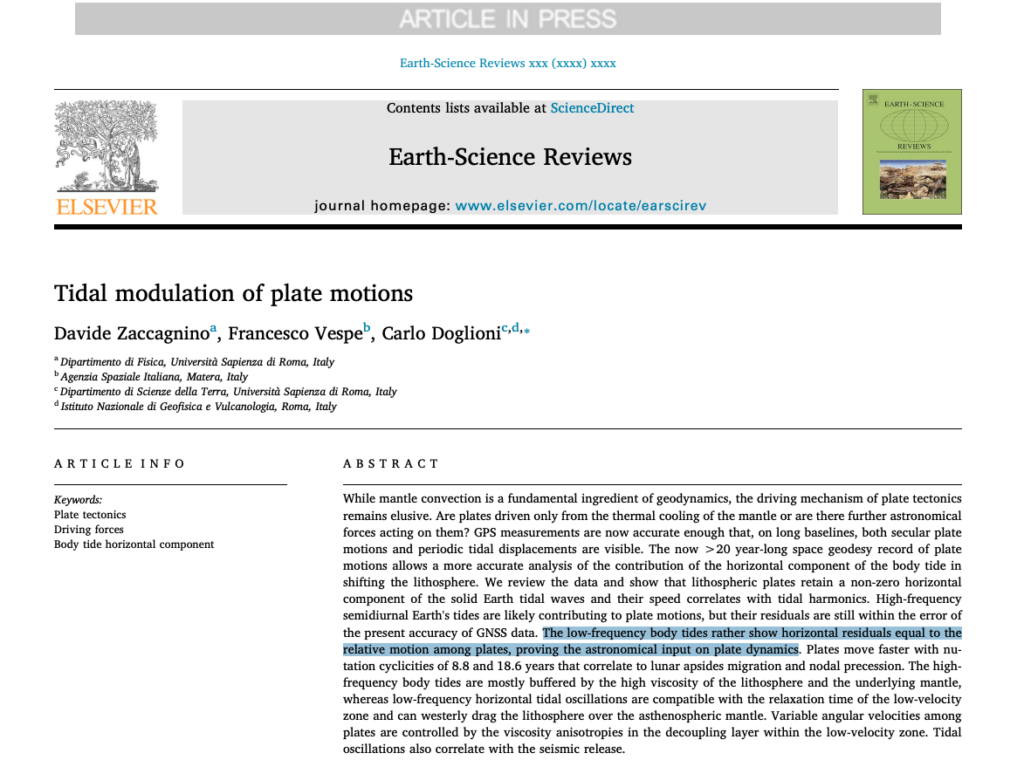
Si veda un approfondimento sul tema: “Come e in quanto tempo una faglia accumula energia che rilascerà con un terremoto?“, clicca QUI.
See an in-depth discussion on the topic: “How and in how much time does a fault accumulate energy that it will release with an earthquake?”, Click HERE.
La scoperta che io sto conducendo in uno studio ad hoc, apporta delle novità rispetto a questa già pur importante asserzione sull’innesco sismico.
Sarebbero le condizioni “stabili” delle forze Newton provenienti dallo spazio a contribuire a questa “forza verticale mareale”, NON un loro picco massimo o minimo di periodo. Queste forze si possono calcolare: questo calcolo è alla base della Timeline del rischio sismico, ossia laddove la Timeline indica rischio significa che le condizioni delle forze Newton esterne alla Terra, sviluppate della masse planetarie del Sistema Solare, dal Sole e dalla Luna sono più stabili che in altri momenti. Il sisma allora viene innescato per lo più al limite di queste fasce di valori Newton stabili, ossia dove alla stabilità, repentinamente si sostituisce una variabilità spiccata di queste forze.
The discovery that I am conducting in an ad hoc study, brings some news with respect to this already important assertion on seismic triggering. It would be the “stable” conditions of the Newtonian forces coming from space to contribute to this “vertical tidal force”, NOT their maximum or minimum period peak. These forces can be calculated: this calculation is the basis of the Timeline of the seismic risk, i.e. where the Timeline indicates risk it means that the conditions of the Newton forces external to the Earth, developed by the planetary masses of the Solar System, the Sun and the Moon are more stable than at other times. The earthquake is then triggered mostly at the limit of these bands of stable Newton values, ie where stability is suddenly replaced by a marked variability of these forces.
La Terra ruota verso est di circa 15° all’ora. Anche i pianeti e specialmente la Luna in quell’ora si muovono. La Terra, inoltre, percorre circa 108.000 km sulla sua eclittica (rivoluzione intorno al Sole) nella stessa ora. Quindi, le condizioni gravitazionali legate alle forze di Newton sono molto variabili nel tempo, se viste da un Osservatore fisso posto sulla Terra.
The Earth rotates east about 15 ° per hour. The planets and especially the Moon are also moving at that time. The Earth also travels about 108,000 km on its ecliptic (revolution around the Sun) in the same hour. Hence, the gravitational conditions related to Newton’s forces are highly variable over time, when viewed from a fixed observer placed on Earth.
Per questi motivi, le condizioni delle forze Newton esercitate su un punto della terra dallo Spazio esterno non sono mai le stesse, ma variano continuamente. Ecco perché trovare dei momenti in cui, considerando 48 ore di misurazione, le forze Newton risultano più stabili in queste 48 ore che in altri tempi precedenti e successivi, è considerata una condizione non solo possibile, ma anche soprattutto misurabile. Queste condizioni sono una delle componenti fondamentali dell’innesco sismico.
For these reasons, the conditions of the Newton forces exerted on a point of the earth from outer space are never the same, but they vary continuously. This is why finding moments in which, considering 48 hours of measurement, the Newton forces are more stable in these 48 hours than in other preceding and subsequent times, is considered a condition that is not only possible, but also above all measurable. These conditions are one of the fundamental components of seismic initiation.
La stabilità della forza Newton che a noi interessa, perché individua i momenti in cui c’è forza di innesco per un terremoto, in realtà occupa quasi il 50% del tempo in un mese. È soltanto abbinando questa componente con altre 3 componenti astronomiche nella Timeline, che riusciamo ad ottenere un tempo abbastanza ristretto (dell’ordine del 15% del tempo totale) in cui i terremoti possono accadere. Un tempo abbastanza ristretto nel ciclo di vita di una persona, quindi un tempo affidabile e sostenibile per poterlo allertare, posto che in questo 15% riusciamo a individuare oltre l’85% di tutti i terremoti >M4, accaduti e che accadranno.
The stability of the Newton force that interests us, because it identifies the moments in which there is triggering force for an earthquake, actually takes up almost 50% of the time in a month. It is only by combining this component with other 3 astronomical components in the Timeline, that we can obtain a fairly short time (of the order of 15% of the total time) in which earthquakes can occur. A fairly short time in a person’s life cycle, therefore a reliable and sustainable time to be able to alert him, given that in this 15% we are able to identify over 85% of all earthquakes> M4, which have occurred and will happen.
Il tempo astronomico dei terremoti del 22.09.2022. The astronomical time of the earthquakes of 09.22.2022.
Vediamo ora il “tempo ciclico astronomico dei terremoti”, in relazione alle figure astronomiche presenti che hanno causato con la loro forza Newton i terremoti del 22.09, in quel momento, non prima, non dopo. Badate, che questa chiave di lettura ispira tutto il nostro progetto EqForecast di previsione dei terremoti.
In particolare, all’ora del terremoto 1), Luna e Sole (c) formavano con la Terra un angolo esattamente di 45°: v. figura seguente, il cerchio C con il sisma 1.
In ascissa il tempo, in ordinata i gradi di angolo dei pianeti rispetto alla Terra e la magnitudo dei terremoti (i pallini grigi).
Let us now see the “astronomical cyclic time of earthquakes”, in relation to the astronomical figures present that caused the earthquakes of 22.09 with their force Newton, at that moment, not before, not after. Mind you, that this interpretation inspires our whole EqForecast project for earthquake prediction.
In particular, at the time of the earthquake 1), the Moon and the Sun (c) formed an angle of exactly 45 ° with the Earth: v. figure below, circle C with earthquake 1.
On the abscissa the time, on the ordinate the degrees of angle of the planets with respect to the Earth and the magnitude of the earthquakes (the gray dots).
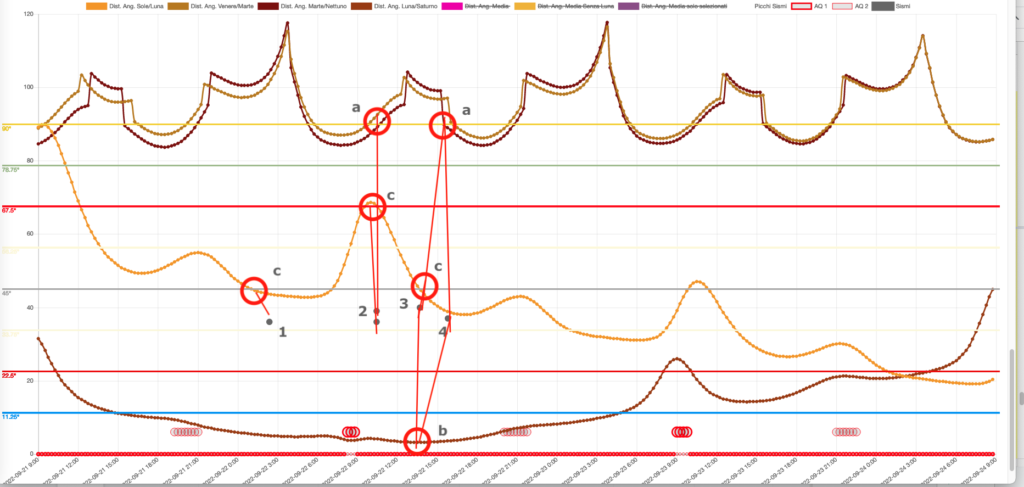
Poi, per il terremoto 2), che è stato leggermente di magnitudo maggiore, avevamo in (a) la Quadratura di Venere/Marte e Nettuno rispetto alla Terra e in (c) Luna e Sole che indugiavano sui 67,5° di angolo rispetto alla Terra. Le linee rosse uniscono il punto di valore d’angolo astronomico con il pallino del terremoto.
Per il terremoto 3) di magnitudo massima di quel giorno, avevamo in (a) sempre la Quadratura di Venere/Marte e Nettuno rispetto alla Terra, in (c) Luna e Sole che passavano nuovamente dai 45° di angolo rispetto alla Terra, in (b) Luna/Saturno in opposizione alla Terra: quest’ultima grandezza si nota dalla linea marrone, che tocca il suo minimo in gradi° proprio dove è segnato l’occhiello rosso, al tempo del terremoto 3. Dopo questo momento, la Luna si sfila dalla linea con Terra e Saturno, la Terra ruota verso est e si innesca l’ultimo terremoto, il 4 che chiude il ciclo. Poi, per alcuni giorni ritorna il “silenzio sismico”.
Then, for the earthquake 2), which was slightly of greater magnitude, we had in (a) the Quadrature of Venus / Mars and Neptune with respect to the Earth and in (c) Moon and Sun that lingered on the 67.5 ° of angle with respect to to the Earth. The red lines join the astronomical angle value point with the earthquake dot.
For the earthquake 3) of maximum magnitude of that day, we always had in (a) the Quadrature of Venus / Mars and Neptune with respect to the Earth, in (c) the Moon and Sun which again passed from an angle of 45 ° with respect to the Earth, in (b) Moon / Saturn in opposition to the Earth: this last magnitude can be seen from the brown line, which touches its minimum in degrees ° right where the red eye is marked, at the time of the earthquake 3. After this moment, the Moon it slips off the line with Earth and Saturn, the Earth rotates eastwards and the last earthquake is triggered, the 4th which closes the cycle. Then, for a few days the “seismic silence” returns.
Ora, vorremmo rispondere a due domande, che magari vi sarete fatti:
Now, we would like to answer two questions, which you may have asked yourself:
1. Perché hanno importanza quegli angoli formati dai pianeti con la Terra?
2. Perché c’è stato silenzio sismico prima e dopo quel 22.09?
Why do those angles formed by the planets with the Earth matter?
Why was there seismic silence before and after 22.09?
Per rispondere alla prima domanda, mi devo rifare ad una delle 4 componenti della Timeline: gli angoli critici.
Una delle scoperte più importanti fatte nel corso dei miei studi sull’innesco sismico, è quella per cui il modello indica la presenza duratura o un repentino sbalzo di uno dei cosiddetti “angoli critici” n(90°/16) con n numero intero: questo numero è il valor medio degli angoli delle posizioni di tutti gli astri del S.S. visto da un Osservatore posto sulla Terra, presso la zona epicentrale potenziale. Nell’esempio schematico della figura seguente, gli angoli che i vari astri del Sistema Solare sottendono con la Terra in ogni momento non dicono molto, se guardati con occhio superficiale. Un calcolo puntuale invece degli stessi angoli ci mostrerà che i terremoti avvengono quando le misure di detti angoli, individualmente presi o anche presi in media, sono prossimi alla formula n(90°/16), con n numero intero (1,16).
To answer the first question, I have to refer to one of the 4 components of the Timeline: the critical angles.
One of the most important discoveries made in the course of my studies on seismic initiation is that the model indicates the lasting presence or a sudden jolt of one of the so-called “critical angles” n (90 ° / 16) with n integer: this number is the average value of the angles of the positions of all the stars of the S.S. seen by an Observer placed on Earth, near the potential epicentral zone. In the schematic example of the following figure, the angles that the various stars of the Solar System subtend with the Earth at any moment do not say much, if looked at with a superficial eye. A precise calculation instead of the same angles will show us that earthquakes occur when the measurements of said angles, individually taken or even taken on average, are close to the formula n (90 ° / 16), with n whole number (1.16).
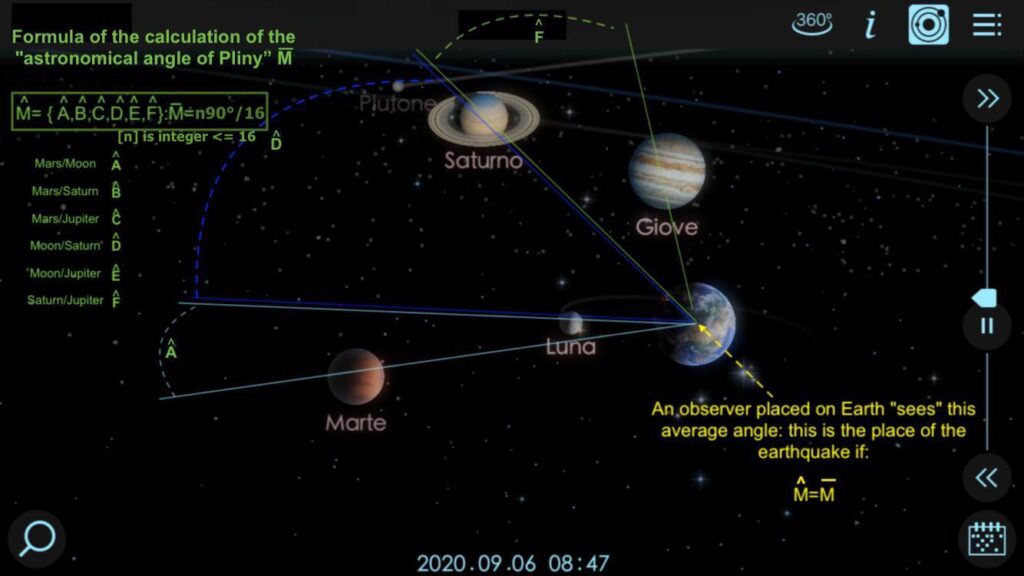
Gli angoli critici: una della 4 componenti della Timeline, vedi: https://www.earthquakesforecast.com/blog/index.php/2022/09/12/la-timeline-del-rischio-sismico-italiano/.
The critical angles: one of the 4 components of the Timeline, see: https://www.earthquakesforecast.com/blog/index.php/2022/09/12/la-timeline-del-rischio-sismico-italiano/.
Sia la permanenza durevole oltre una certa soglia temporale, che il repentino sbalzo di questi valori angolari prima o dopo il tempo di stabilità durevole, sono quindi entrambe cause necessarie esterne di innesco di un terremoto. I 45° ed i 67,5° di Sole e Luna, individuati dalle linee colorate di livello del grafico sopra, sono proprio due di questi valori n(90°/16).
Both the lasting permanence beyond a certain temporal threshold, and the sudden change of these angular values before or after the time of lasting stability, are therefore both necessary external causes of triggering an earthquake. The 45 ° and 67.5 ° of the Sun and the Moon, identified by the colored level lines of the graph above, are just two of these n values (90 ° / 16).
Per rispondere alla seconda domanda, introduco un nuovo grafico, che spiega cosa è successo quel 22.09, e non è successo invece nei giorni precedenti (o seguenti) dal punto di vista astronomico. Si vedano i seguenti grafici, 1 e 2.
To answer the second question, I introduce a new graph, which explains what happened that 22.09, and did not happen in the previous (or following) days from an astronomical point of view. See the following graphs, 1 and 2.
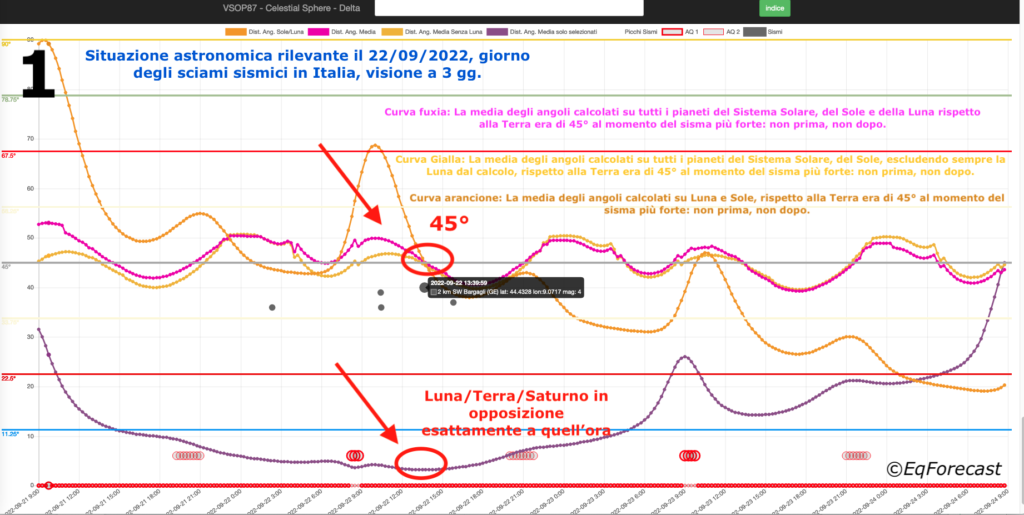
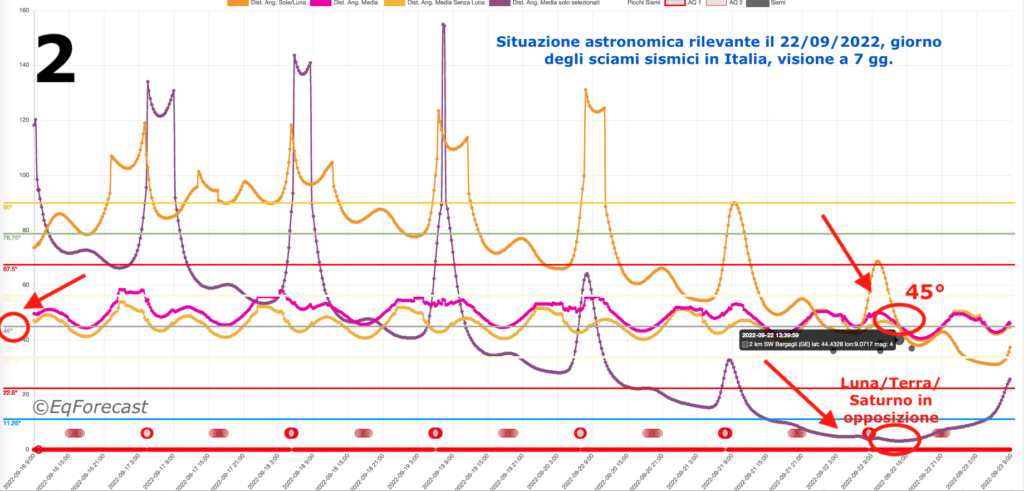
Nella figura 1 si vede la situazione a 3 giorni intorno al giorno dello sciame sismico del 22.09. Come sempre, in ascissa il tempo, in ordinata i gradi di angolo dei pianeti rispetto alla Terra e la magnitudo dei terremoti (i pallini grigi).
Figure 1 shows the 3-day situation around the day of the seismic swarm of 22.09. As always, on the abscissa the time, on the ordinate the degrees of angle of the planets with respect to the Earth and the magnitude of the earthquakes (the gray dots).
Rispetto al grafico che abbiamo visto più sopra, questo grafico introduce altre due curve, 2 grandezze che abbiamo introdotto vicino alla curva arancione che descrive l’angolo formato da Luna e Sole rispetto alla Terra: si tratta di una curva di color fucsia e di una curva di color giallo.
Compared to the graph we have seen above, this graph introduces two other curves, 2 quantities that we introduced near the orange curve that describes the angle formed by the Moon and the Sun with respect to the Earth: it is a fuchsia-colored curve and a yellow curve.
La curva fucsia indica il valore dell’angolo medio calcolato rispetto alla Terra calcolato su tutte le 36 coppie possibili dei pianeti del Sistema Solare, del Sole e della Luna, rispetto alla Terra. Quindi lì dentro c’è il valore degli angoli ad esempio di Nettuno-Marte-Terra, di Sole-Mercurio-Terra, di Luna-Venere-Terra e così via, per tutte le n(n-1)/2 combinazioni possibili di coppie di pianeti che vi vengono in mente e su cui possiamo prendere la misura d’angolo.
The fuchsia curve indicates the value of the average angle calculated with respect to the Earth calculated on all 36 possible pairs of the planets of the Solar System, the Sun and the Moon, with respect to the Earth. So inside there is the value of the angles for example of Neptune-Mars-Earth, of Sun-Mercury-Earth, of Moon-Venus-Earth and so on, for all the n (n-1) / 2 possible combinations of pairs of planets that come to your mind and on which we can take the angle measurement.
Il valor medio di tutto questo è la curva fucsia, momento per momento. È quindi una sorta di valore medio universale di tutte le grandezze del Sistema Solare che conosciamo e che stiamo misurando, come misura angolare rispetto alla Terra, istante per istante. La curva gialla invece indica le stesse grandezze, ma senza mettere nel calcolo angolare la Luna. Quindi sono escluse tutte le coppie che hanno la Luna come elemento, ad esempio è esclusa la coppia Venere-Luna-Terra o Marte-Luna-Terra o Sole-Luna-Terra.
The average value of all this is the fuchsia curve, moment by moment. It is therefore a sort of universal average value of all the quantities of the Solar System that we know and that we are measuring, as an angular measure with respect to the Earth, instant by instant. The yellow curve, on the other hand, indicates the same quantities, but without putting the Moon in the angular calculation. Therefore all couples that have the Moon as an element are excluded, for example the couple Venus-Moon-Earth or Mars-Moon-Earth or Sun-Moon-Earth is excluded.
Si nota allora sia nel grafico 1 che nel grafico 2, che le 3 curve si incontrano curiosamente sulla linea dei 45°, proprio all’orario spaccato del terremoto maggiore, il numero 3 della lista, quello di Genova: e questa cosa non accade nei giorni precedenti nei seguenti quel momento!
It is then noted both in graph 1 and in graph 2, that the 3 curves curiously meet on the 45 ° line, precisely at the split time of the major earthquake, the number 3 of the list, that of Genoa: and this thing does not happen in the previous days in the following that moment!
La misurazione di questo fenomeno fa proprio parte di uno dei quattro algoritmi della timeline [si veda, ripeto i 4 algoritmi che la formano cliccando su questo link: https://www.earthquakesforecast.com/blog/index.php/2022/09/12/la-timeline-del-rischio-sismico-italiano/: è proprio il comportamento angolare della Luna, quando va in risonanza con il comportamento angolare di tutti gli altri pianeti a innescare il sisma, ossia a causare quella “componente verticale” mareale che muove le cariche litostatiche ormai giunte a maturazione. Lo fa, in un tempo ciclico astronomico, e quando i Newton generati sono stabili nel tempo per 48 ore: quindi non a caso o per una “legge dei grandi numeri“, come asseriscono i geologi!
The measurement of this phenomenon is part of one of the four algorithms of the timeline [see, I repeat the 4 algorithms that form it by clicking on this link: https://www.earthquakesforecast.com/blog/index.php/2022/09/12/la-timeline-del-rischio-sismico-italiano/: it is precisely the angular behavior of the Moon, when it resonates with the angular behavior of all the other planets, that triggers the earthquake, that is to say that it causes that “vertical component “tide that moves the lithostatic charges which have now reached maturity. It does so, in an astronomical cyclical time, and when the generated Newtons are stable over time for 48 hours: therefore not by chance or by a “law of large numbers”, as geologists assert!
Abbiamo visto sopra lo studio di un Fisico, un Astrofisico e un Geofisico, che ci hanno illustrato come la componete astronomica esterna, orizzontale e verticale creino l’innesco sismico. Questo è senz’altro lo studio più recente e più approfondito sul tema, quello che potrebbe essere la pietra miliare del trait-d’union fra geologia e astronomia per spiegare l’innesco dei terremoti.
We have seen above the study of a Physicist, an Astrophysicist and a Geophysicist, who have shown us how the external, horizontal and vertical astronomical components create the seismic trigger. This is undoubtedly the most recent and most in-depth study on the subject, what could be the cornerstone of the trait-d’union between geology and astronomy to explain the triggering of earthquakes.
Eppure, di qualche anno prima c’è un altro studio, sempre di italiani, a cura di un Fisico e di un Geologo, che nel 2011 hanno pubblicato: Vol.3 No.9, September 2011, Natural Science, Vol.3 No.9(2011), Paper ID 7644, 7 pages, DOI:10.4236/ns.2011.39101 “Time and space analysis of two earthquakes in the Appennines (Italy)”, di Michele Caputo, Giovanni Sebastiani.
Yet, a few years earlier there is another study, also by Italians, by a Physicist and a Geologist, who in 2011 published: Vol.3 No.9, September 2011, Natural Science, Vol.3 No.9(2011), Paper ID 7644, 7 pages, DOI:10.4236/ns.2011.39101 “Time and space analysis of two earthquakes in the Appennines (Italy)”, di Michele Caputo, Giovanni Sebastiani.
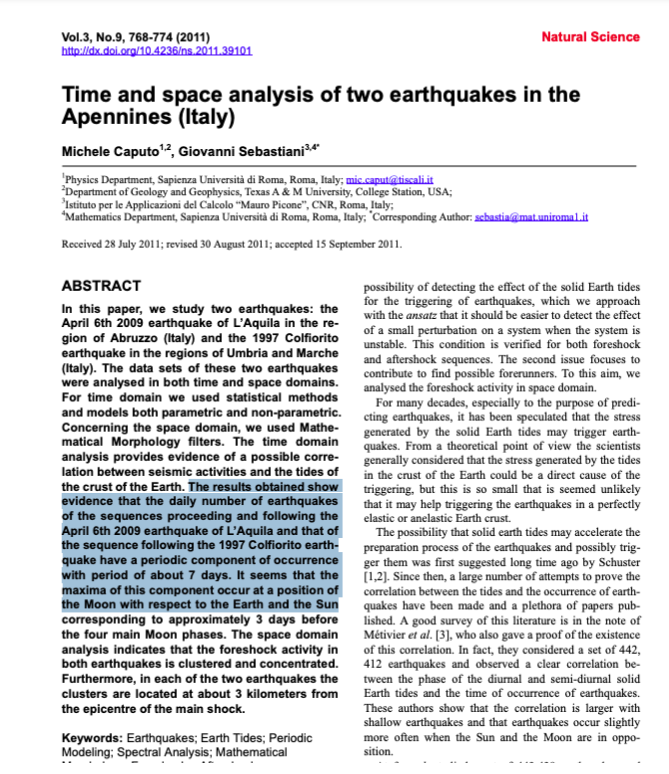
Nell’articolo i due autori evidenziano la ciclicità di alcuni sciami sismici nelle due zone analizzate di Colfiorito e l’Aquila, mostrando i grafici in cui indicano il numero di terremoti avvenuti sia prima che dopo il mainshock ed evidenziandone i periodo di ciclicità di 6,7 o 7,1 giorni.
In the article the two authors highlight the cyclical nature of some seismic swarms in the two analyzed areas of Colfiorito and L’Aquila, showing the graphs in which they indicate the number of earthquakes that occurred both before and after the mainshock and highlighting the period of cyclicality of 6, 7 or 7.1 days.
Il primo dei due grafici seguenti è quello sviluppato dei due ricercatori: ognuna delle quattro curve indica, alla sua sommità, la massima concentrazione di terremoti anche di piccola magnitudo in tempi regolari, ogni sette giorni: si tratta dei terremoti che precedettero il Mainshock, quindi siamo ancora a tra gennaio e febbraio 2009.
The first of the two graphs below is the one developed by the two researchers: each of the four curves indicates, at its top, the maximum concentration of earthquakes even of small magnitude at regular times, every seven days: these are the earthquakes that preceded the Mainshock, therefore we are still in between January and February 2009.
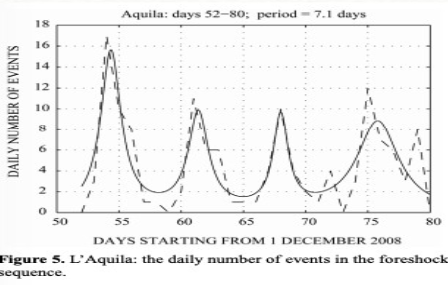
Ad ogni picco dei quattro della curva nel grafico dei due ricercatori, corrisponde lo sciame sismico indicato dai quattro cerchi del grafico sotto fatto da me. In questo secondo grafico, con quadratini neri evidenzio l’incrocio della curva fucsia con la linea dell’angolo critico di 45°. La curva fucsia in questo caso è la media degli angoli misurati considerando soltanto la Luna e i pianeti Marte, Saturno e Giove, cioè i tre pianeti maggiori del sistema solare.
To each peak of the four of the curve in the graph of the two researchers, corresponds the seismic swarm indicated by the four circles of the graph below made by me. In this second graph, with black squares I highlight the intersection of the fuchsia curve with the line of the critical angle of 45 °. The fuchsia curve in this case is the average of the angles measured considering only the Moon and the planets Mars, Saturn and Jupiter, that is, the three major planets of the solar system.
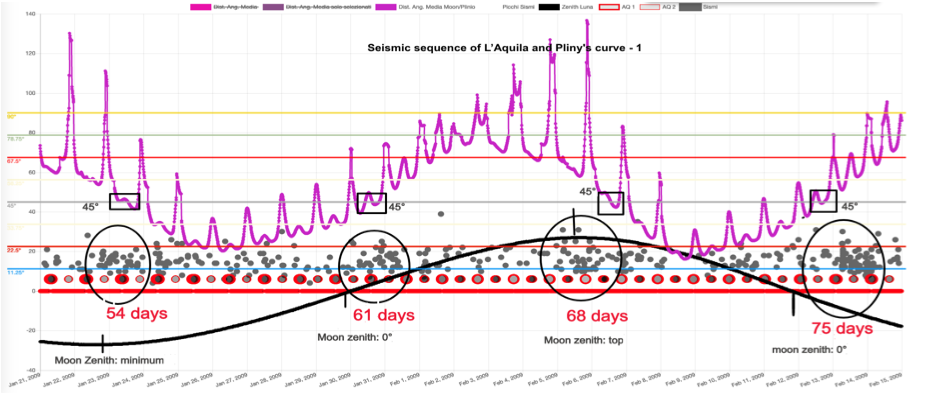
Come si vede il risultato non cambia, anche se abbiamo cambiato il calcolo nella curva rappresentata: la regola della ciclicità dei terremoti è osservata: lo sciame sismico accade in corrispondenza di un evento astronomico ricorrente e ciclico, ossia la valorizzazione della curva angolare a 45°, ed è osservata anche quella della correlazione fra gli “angoli critici” n(90°/16) cioè appunto di 45°, e l’innesco sismico.
As you can see, the result does not change, even if we have changed the calculation in the curve represented: the rule of the cyclicality of earthquakes is observed: the seismic swarm occurs in correspondence with a recurring and cyclic astronomical event, i.e. the enhancement of the angular curve at 45 ° , and the correlation between the “critical angles” n (90 ° / 16), ie 45 °, and the seismic trigger is also observed.
Che poi questo tipo di analisi ci potesse portare a prevedere correttamente il terremoto dell’Aquila il 6 aprile 2009, è una diretta conseguenza: nel grafico seguente vedete come le curve già viste sopra assumono dei valori del tutto coerenti con il modello teorico finora esposto.
This type of analysis can then lead us to correctly predict the L’Aquila earthquake on April 6, 2009: it is a direct consequence. In the following graph you can see how the curves already seen above assume values that are completely consistent with the theoretical model exposed so far.
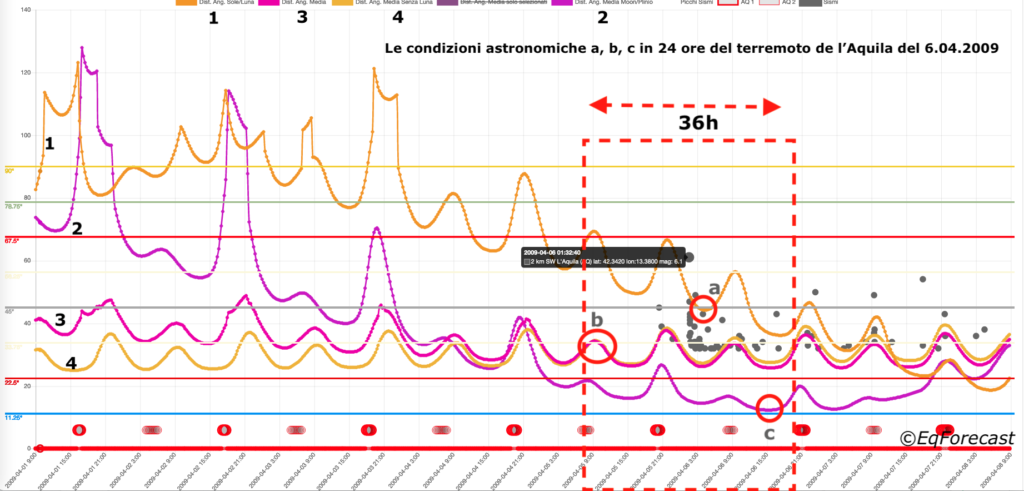
Nel grafico trovate quattro curve, numerate dalla 1 alla 4, che creano 3 figure astronomiche: a, b c. La curva 1 della distanza angolare di Sole-Luna-Terra incontra ed indugia sulla linea dell’angolo critico dei 45° (a) proprio all’ora del terremoto principale. La curva 2 della distanza angolare di degli angoli formati con la Terra dalla Luna con Marte, Saturno, Giove incontra ed indugia sulla linea dell’angolo critico dei 11,25° (c) 12 ore dopo l’ora del terremoto principale. Le curve 3 e 4 della distanza angolare media e media senza calcolare la Luna (identica a quella già spiegata per lo sciame del 22.09.2022) si incontrano ed indugiano sulla linea dell’angolo critico dei 56,25° (b) 17 ore prima dell’ora del terremoto principale.
In the graph you will find four curves, numbered from 1 to 4, which create 3 astronomical figures: a, b c. Curve 1 of the angular distance of the Sun-Moon-Earth meets and lingers on the line of the critical angle of 45 ° (a) just at the time of the main earthquake. Curve 2 of the angular distance of angles formed with the Earth by the Moon with Mars, Saturn, Jupiter meets and lingers on the line of the critical angle of 11.25 ° (c) 12 hours after the time of the main earthquake. Curves 3 and 4 of the average and average angular distance without calculating the Moon (identical to that already explained for the swarm of 09.22.2022) meet and linger on the line of the critical angle of 56.25 ° (b) 17 hours earlier of the time of the main earthquake.
Solo per fare un altro esempio, poiché lo stesso meccanismo tramite le configurazioni astronomiche descritte spiega il tempo di qualunque terremoto, possiamo vedere che similmente è stato innescato il terremoto di Amatrice (RI) del 24.08.2016, v. figura seguente. Lo schema astronomico si realizza, in questo caso in sole 24 ore.
Just to give another example, since the same mechanism through the described astronomical configurations explains the time of any earthquake, we can see that the Amatrice earthquake (RI) of 08.24.2016 was similarly triggered. figure below. The astronomical scheme is realized, in this case in just 24 hours.
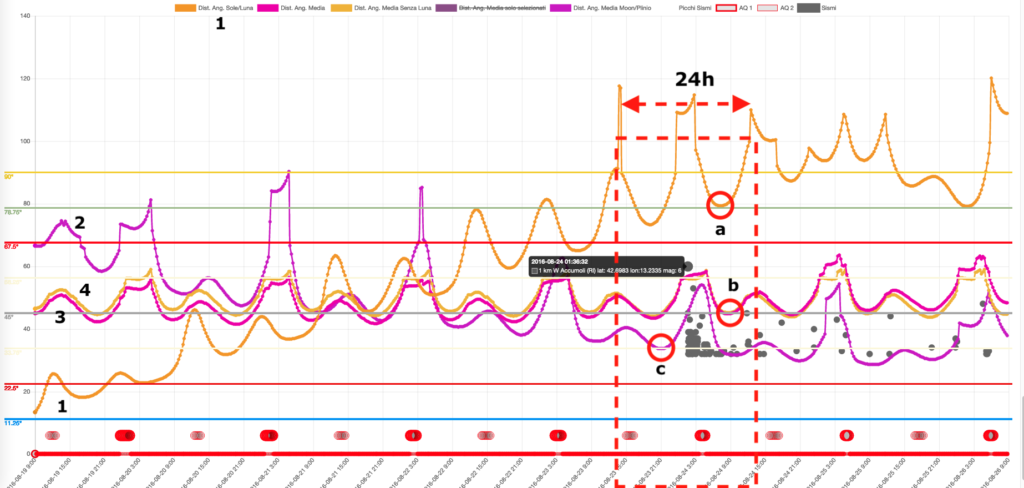
Conclusioni Conclusions
È stato forse un po’ complesso dimostrare in poche righe di un articolo scritto per tutti e non per pochi addetti l’origine astronomica della sismicità del 22 settembre 2022. Ma io non mi stanco di spiegare, perché la Scienza è patrimonio comune, nonostante molti “esperti” siano invece molto abbottonati su questi argomenti e si tengano le scoperte per sè, facendo finta che siano cose “riservate”.
It was perhaps a bit complex to demonstrate in a few lines of an article written for everyone and not for a few insiders the astronomical origin of the seismicity of September 22, 2022. But I never tire of explaining, because science is a common heritage, despite many “experts” are instead very buttoned up on these topics and keep the discoveries for themselves, pretending that they are “confidential” things.
Eppure, si tratta di grandezze e argomenti utilizzati dagli stessi geologi ed astrofisici, di cui abbiamo ripreso i lavori pubblicati, a mo’ di esempio. Ma alcuni di essi, se intervistati dopo il sisma ti rispondono sempre che “non c’è una logica nell’innesco sismico”, ma che i terremoti avvengono in maniera “del tutto imprevedibile e casuale”.
Yet, these are quantities and arguments used by the same geologists and astrophysicists, of which we have taken up the published works, as an example. But some of them, if interviewed after the earthquake, always answer that “there is no logic in seismic triggering”, but that earthquakes occur in a “completely unpredictable and random” way.
Invece, è utilizzando proprio la Narrativa e Letteratura di ricercatori formati alla Fisica classica e alla Geologia, nobili materie, che possiamo arrivare a queste conclusioni, smentendo come non sia affatto “la legge dei grandi numeri” a stabilire l’innesco sismico, ma al contrario una logica ciclica, preordinata e calcolabile di eventi astronomici esterni: le faglie accumulano energia nei decenni, a causa della componente orizzontale di marea: “il terremoto avviene quando la soglia critica è raggiunta e lì la componente verticale della marea può contribuire all’innesco (che può avvenire anche in tempi non coincidenti) in modo opposto in funzione dell’ambiente tettonico perché il carico litostatico favorisce le faglie normali e inibisce le faglie inverse“ (Doglioni, 2020).
Instead, it is using the Narrative and Literature of researchers trained in classical Physics and Geology, noble subjects, that we can reach these conclusions, denying that it is not at all “the law of large numbers” that establishes the seismic trigger, but on the contrary, a cyclical, preordained and calculable logic of external astronomical events: the faults accumulate energy over the decades, due to the horizontal component of the tide: “the earthquake occurs when the critical threshold is reached and there the vertical component of the tide can contribute to the triggering (which can also occur in non-coincident times) in the opposite way depending on the tectonic environment because the lithostatic load favors normal faults and inhibits reverse faults “(Doglioni, 2020).
I terremoti avvengono con una ciclicità, un tempo astronomico, del tutto prevedibile e calcolabile, diverso dal nostro “tempo solare”, perché basato sulla ripetitiva ciclicità di un tempo gravitazionale prodotto da tutti i pianeti, non solo dal Sole e dalla Luna.
Earthquakes occur with a cyclicality, an astronomical time, completely predictable and calculable, different from our “solar time”, because it is based on the repetitive cyclicality of a gravitational time produced by all the planets, not only by the Sun and the Moon.
La stessa misurazione dei Newton, della loro stabilità nell’intorno del terremoto, risulta tanto più precisa ed attendibile ai fini della previsione dei terremoti, tanto più la si calcola su una base che comprende tutti i 9 elementi del Sistema Solare, Luna e Sole inclusi, e non solo su alcuni elementi di esso: su questo calcolo di confronto tra i Newton calcolati sui 9 elementi, piuttosto che sul calcolo di soli 7 o 2 elementi (es: soltanto Sole e Luna) del Sistema Solare sto redigendo un interessante articolo per una peer review, che consentirà proprio di testimoniare come tutto il Sistema Solare sia alla fine coinvolto nell’innesco sismico sulla Terra.
The measurement of the Newtons themselves, of their stability around the earthquake, is all the more precise and reliable for the purposes of earthquake prediction, the more it is calculated on a basis that includes all 9 elements of the Solar System, Moon and Sun included. , and not only on some elements of it: on this calculation of comparison between the Newtons calculated on the 9 elements, rather than on the calculation of only 7 or 2 elements (eg only the Sun and the Moon) of the Solar System I am writing an interesting article for a peer review, which will allow us to testify how the entire Solar System is ultimately involved in the seismic triggering on Earth.
L’origine dei terremoti è quindi astronomica, sia per la sua componente orizzontale di accumulo, che per la sua componente verticale della spinta e segue un tempo ciclico calcolabile: con buona pace di chi dice il contrario.
The origin of earthquakes is therefore astronomical, both for its horizontal component of accumulation, and for its vertical component of the thrust and follows a cyclical time that can be calculated: with all due respect to those who say the opposite.
Le quattro basi teoriche unificanti. The four unifying theoretical foundations.
Spero di essere riuscito a delineare un impianto teorico stabile – o almeno una base di questo – perché tutte le persone conoscano il fatto che i terremoti hanno origine esterna cioè astronomica, rispetto alla Terra.
I hope I have succeeded in delineating a stable theoretical framework – or at least a basis for this – so that all people know the fact that earthquakes have an external, that is astronomical, origin, with respect to the Earth.
Ritengo anche di aver trovato 4 “basi teoriche unificanti” tra le tesi della Comunità Scientifiche e quelle spesso definite “eretiche” del modello astronomico di previsione terremoti Eqforecast.
I also believe that I have found 4 “unifying theoretical bases” between the theses of the Scientific Community and those often defined as “heretical” of the astronomical model of earthquake prediction Eqforecast.
Le 4 basi teoriche unificanti sarebbero:
1)
I terremoti vengono innescati dall’azione mareale del Sole e della Luna, attraverso il movimento orizzontale di marea luni-solare che fa accumulare alla faglia energia nel corso dei decenni. Il rilascio energetico avviene poi per l’azione verticale della stessa marea, anche in tempi non coincidenti. (Doglioni, Vespe, Zaccagnino – INGV)
2)
I TERREMOTI avvengono con regolarità ciclica stabilita da determinate figure astronomiche ricorrenti e calcolabili, secondo un “tempo gravitazionale” che comprende nel calcolo gli “angoli critici” formati da tutti i 9 astri del sistema solare, inclusi Luna e Sole nei confronti della Terra (Caputo, Sebastiani – Dip. Fisica Univ. Sapienza) (Calandra -CEO EqForecast).
3)
La stabilità dei valori di forza Newton generati dai 9 astri del Sistema Solare, Luna e Sole inclusi, nei confronti della Terra contribuiscono in maniera determinante alla componente verticale mareale che comporta il rilascio litostatico nelle faglie, in definitiva all’innesco sismico. (Calandra)
4)
Il comportamento angolare della Luna, quando va in risonanza con il comportamento angolare di tutti gli altri pianeti, innesca il sisma, ossia causa quella “componente verticale” mareale che muove le cariche litostatiche ormai giunte a maturazione.
The 4 unifying theoretical bases would be:
1)
Earthquakes are triggered by the tidal action of the Sun and the Moon, through the horizontal movement of the lunar-solar tide that causes the fault to accumulate energy over the decades. The energy release then occurs due to the vertical action of the same tide, even in non-coincident times. (Doglioni, Vespe, Zaccagnino – INGV)
2)
EARTHQUAKES occur with cyclic regularity established by certain recurring and calculable astronomical figures, according to a “gravitational time” which includes in the calculation the “critical angles” formed by all 9 stars of the solar system, including the Moon and the Sun towards the Earth (Caputo , Sebastiani – Dept. Physics Univ. Sapienza) (Calandra -CEO EqForecast).
3)
The stability of the Newton force values generated by the 9 stars of the Solar System, Moon and Sun included, towards the Earth contribute significantly to the vertical tidal component that involves the lithostatic release in the faults, ultimately to the seismic trigger. (S. Calandra)
4)
The angular behavior of the Moon, when it resonates with the angular behavior of all the other planets, triggers the earthquake, ie it causes the tidal “vertical component” that moves the lithostatic charges which have now reached maturity.
I TERREMOTI del 22.09.2022 SONO STATI PREVISTI.THE EARTHQUAKES of 09.22.2022 HAVE BEEN FORECASTED.
I terremoti 1), 2 e 4) sono stati ben presi dall’App, nelle 3 dimensioni del quando-dove-quanto, mentre il terremoto 3 NON è stato preso. Bisogna però tenere conto che si tratta di sismicità leggera M<4.3, come era stato previsto d’altronde, per la quale nelle istruzioni dell’app è specificato che l’affidabilità delle previsioni è inferiore all’80%.
Earthquakes 1), 2 and 4) were well taken by the App, in the 3 dimensions of when-where-how much, while earthquake 3 was NOT caught. However, it must be taken into account that it is a light seismicity M <4.3, as it was predicted, for which the app instructions specify that the reliability of the forecasts is less than 80%.
Ad esempio, il terremoto 3 è stato preso dalla Timeline (pubblicata in data 20.09.2022), proprio al suo bordo destro, come abbiamo visto sopra.
La Timeline fornisce il rischio sismico previsto nelle due dimensioni della Magnitudo e del Tempo, e viene pubblicata sull’App EqForecast nel Menu –> Timeline ed aggiornata ogni 15 gg: prevede il rischio sismico fino a 15 giorni. La magnitudo massima prevista era M4.3, come infatti è stato.
For example, earthquake 3 was taken from the Timeline (released on 09.20.2022), right at its right edge, as we saw above. The Timeline provides the expected seismic risk in the two dimensions of Magnitude and Time, and is published on the EqForecast App in the Menu -> Timeline and updated every 15 days: it predicts the seismic risk up to 15 days. The maximum expected magnitude was M4.3, as indeed it was.
L’ubicazione del terremoto era stata prevista dalle mappe presenti nella home dell’App Eqforecast, ecco un rendering registrato 1 minuto prima dell’evento sismico, dove si vede il marker dell’epicentro che il software ha scelto come precursore utile a segnalare all’utenza entro i 30-40 km dell’arrivo imminente di una scossa, tramite la notifica sonora sul cellulare entro 5 minuti PRIMA dell’evento.
The location of the earthquake was predicted by the maps present in the home of the Eqforecast App, here is a rendering recorded 1 minute before the seismic event, where you can see the epicenter marker that the software has chosen as a useful precursor to report to the users within 30-40 km of the imminent arrival of an earthquake, via the sound notification on the mobile phone within 5 minutes BEFORE the event.
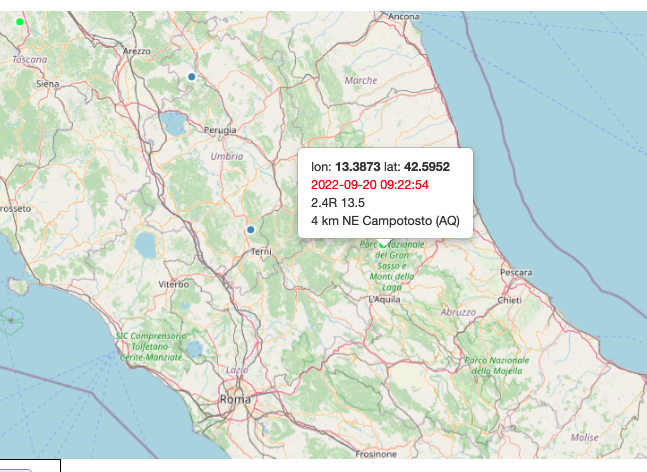
Terremoto precursore del 20.09 previsto da EqForecast: l’area epicentrale possibile è in un raggio di 40 km dal precursore, entro la quale vengono allertati con notifica sonora tutti gli utenti iscritti all’App EqForecast ed abbonati al servizio.
Precursor earthquake of 20.09 foreseen by EqForecast: the possible epicentral area is within a radius of 40 km from the precursor, within which all users registered with the EqForecast App and subscribers to the service are alerted with sound notification.
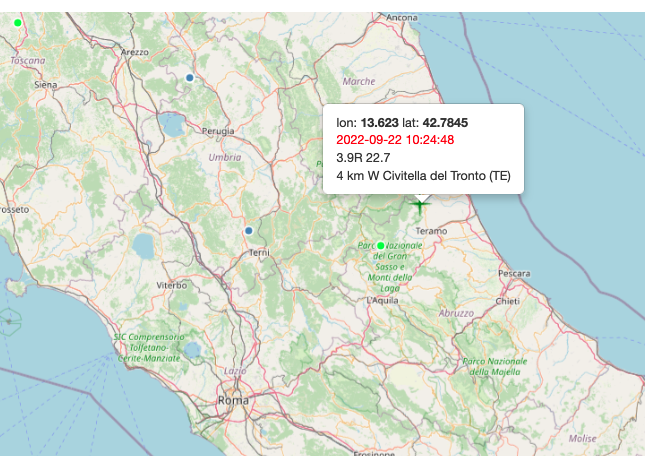
Terremoto principale del 22.09.2022 a Civitella del Tronto (TE)
Il marker verde della prima figura è di un terremoto di M2.4, del 20.09.2022 che il software ha scelto fra tanti, perché era quello compatibile con la ciclicità del terremoto (come sopra spiegato) e con la statistica dei terremoti che si trovano in pancia del sistema. Ho spiegato sopra il meccanismo temporale della successione ciclica degli eventi.
The green marker of the first figure is of an earthquake of M2.4, of 20.09.2022 that the software has chosen among many, because it was the one compatible with the cyclical nature of the earthquake (as explained above) and with the statistics of the earthquakes that are found. in the belly of the system. I explained above the temporal mechanism of the cyclic succession of events.
L’aspetto astronomico ci fornisce anche la spiegazione del DOVE, con un calcolo statistico che restituisce la/le località più probabili per un sisma, a parità di condizioni astronomiche storiche rispetto al momento presente.
Cioè, troviamo il luogo del futuro terremoto, rispondendo alla domanda: dove sono accaduti in maggior numero dei terremoti nel passato con questa stessa configurazione astronomica attuale?
Un robot con in pancia questi dati riesce a tirare fuori agevolmente la località del sisma futuro. La nostra app funziona in questo modo.
The astronomical aspect also provides us with the explanation of WHERE, with a statistical calculation that returns the most likely location (s) for an earthquake, with the same historical astronomical conditions compared to the present moment. That is, we find the place of the future earthquake, answering the question: where have more earthquakes occurred in the past with this same current astronomical configuration? A robot with this data in its belly can easily pull out the location of the future earthquake. Our app works like this.
La successione degli eventi di ieri 22.09.2022 comunque esula in parte da questo ragionamento: nel senso che le condizioni astronomiche adatte ci sono spesso e non è che ogni volta fanno scatenare un terremoto.
È la capacità di accumulo energetico di ciascuna faglia che poi, raggiunta una certa misura, rilascia energia. E questo può avvenire – in base al nostro modello – sì nel momento in cui si attivano questi fattori astronomici, ma non ogni volta: alcune volte non accade proprio nulla e allora li chiamiamo falsi allarmi.
The succession of events of yesterday 22.09.2022, however, is partly beyond this reasoning: in the sense that there are often suitable astronomical conditions and it is not that every time they trigger an earthquake. It is the energy storage capacity of each fault which then, once reached a certain extent, releases energy. And this can happen – according to our model – yes when these astronomical factors are activated, but not every time: sometimes nothing really happens and then we call them false alarms.
C’è sicuramente una ragione anche astronomica particolare per cui in alcuni momenti in cui queste condizioni astronomiche ci sono, accade il terremoto, e altre volte no. Ma su questo ancora non abbiamo fatto luce.
Comunque nessun problema, l’importante è sapere che la magnitudo massima attesa è quella, e che non dobbiamo temere di più: anche perché stando alla Timeline del rischio sismico, fino al 27.09 non dovremmo più registrare in terra nessun altro terremoto > M4.
There is certainly a particular astronomical reason why in some moments in which these astronomical conditions exist, an earthquake occurs, and other times not. But we haven’t shed any light on this yet. However, no problem, the important thing is to know that the maximum expected magnitude is that, and that we need not fear more: also because according to the Seismic Risk Timeline, until 27.09 we should no longer record any other earthquakes> M4.
Un caro saluto. ![]()
———————
Stefano Calandra.
©EqForecast Earthquakes Forecast – The Gravitational Theory.
Email: info@earthquakesforecast.com
Web: www.earthquakesforecast.com
Telegram & Twitter: https://t.me/eqforecast; twitter.com/eqforecast
FB: https://www.facebook.com/groups/EarthquakesForecast/
Youtube: https://www.youtube.com/c/EqForecastChannel
Per approfondire
Chi desidera approfondire può leggere il libro divulgativo dell’autore del presente modello, disponibile al link:
https://www.earthquakesforecast.com/Libro_EqF_approved_Albatros.pdf
L’elenco completo delle pubblicazioni dell’autore è disponibile tramite il suo profilo ORCID:
https://orcid.org/0000-0001-5324-2298